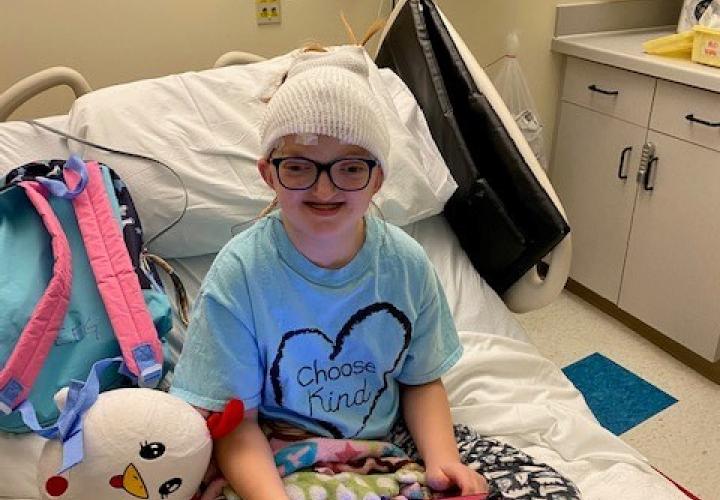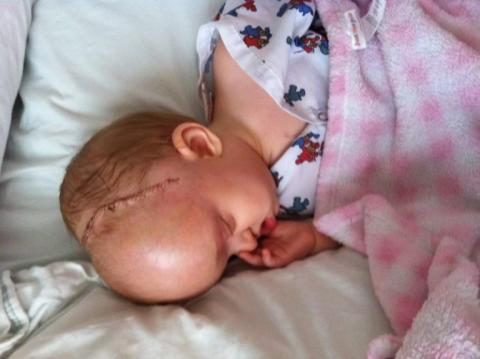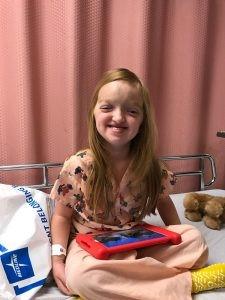The seizures continue, along with more hospital trips, testing and a second skull surgery
Over the next several months, episodes of what we thought were seizures began to appear more often, at least every few weeks, which earned us a few more trips to the Emergency Department at Connecticut Children’s. After a couple of trips to the hospital we sat down with Dr. Madan-Cohen and developed a plan of care for when these episodes occurred so we could manage them at home. They were not sure why the seizures were continuing to happen, but it prompted further testing and the results coupled with what the Ophthalmologist found once again with swollen optic nerves, led us to skull surgery number two.
We felt better prepared this time knowing what to pack for the hospital, what to expect with Emma after surgery, and furthermore what our discharge home would be like. As any parents would be, we were still nervous and knew recovery would be tough because she was two now, and how would we ever keep her calm and entertained while she recovered? We knew her facial appearance would once again change, so a few days prior to surgery I began calling around looking for a photographer to take professional photos of her. I already fell in love her with face not once, but twice and knew that it would yet again look different following surgery. I loved that little face so much that I wanted to capture it. When the photographer heard our story, she never charged us for the photo session, and as it turned out her daughter was a nurse at Connecticut Children’s.
The surgery day arrived, and six and half hours later surgery was complete, and Emma was heading to the PICU. To our surprise she did not look very different. They only operated on the front of her skull this time once again placing pins and plates and expanding her head to allow for her brain to have room to grow. Within a few hours after surgery Emma was sitting up in bed eating a banana and a peanut butter and jelly sandwich acting like nothing had ever happened. About five days later we went home, and back to life.
Frequent headaches at 4 years old required another surgery
Fast forward to March of 2017. Emma was now four years old and loving pre-school. She began complaining of headaches and eye pain, which then moved to what we thought were seizure episodes again. She was heading to the school nurse almost daily, and when she was playing, she would start crying because her head would hurt. We went through most of her specialists; ENT, Ophthalmology, Neurology, Neurosurgery, Craniofacial, had an MRI done, and then a spinal tap, which gave us our answer. Emma had too much fluid in her head because her skull was once again compressing her brain. The Craniofacial Team began devising a plan to help Emma. By this time, it was May. The plan was that they were going to expand just the back of her skull to create more space for Emma’s “smart brain” as she called it.
We have always been very open with Emma with what is coming for surgeries, procedures or appointments, so we began to prepare her. She started telling her friends and teachers that her “smart brain” needed room so she would have surgery to open up her head. I am not sure how the kids in class handled it, but Emma seemed at ease talking about it.
This surgery took almost 6 hours and titanium plates were placed in the back of Emma’s head. The surgeons were able to go in through the same scar over her head and minimally shaved her head, you could barely even tell. The swelling was minimal, and once again Emma was up eating just a few hours following surgery. Besides some restrictions for a month following surgery, Emma was doing great. Immediately the headaches, eye pain, and seizures stopped. She woke up happy each day and was no longer complaining of discomfort.
To this date, Emma remains seizure free and is preparing for her next big craniofacial surgery.
Over the next few years Emma continued to follow up with her many specialists, which seemed to space out a bit, which was nice. She did go three and half years without seizures and was actually weaned off of her medication. Then in 2020 the seizures returned and presented very differently. Once again Emma followed up with most of her providers to figure out why they had started again. After multiple tests and studies the providers could not determine a reason as to why the seizures had begun again. Emma was started back on her medication, and it took time to figure which medication worked best for her. Today, it has been two years since her last seizure and the medication seems to be working. Emma has regular follow-up appointments with all of her specialists, and some she sees more frequently than others. We are now in preparation for her next big surgery the Lefort 3 for her midface advancement, which should take place within the next year.
My husband and I are always thankful for Emma and how well she is doing. Now we try to raise awareness about Craniofacial disorders any way we can. We love Craniofacial, the patients, and their families. I don’t wish that Emma had to go through all that she has, but I am grateful that I understand firsthand what the patients and families go through.


